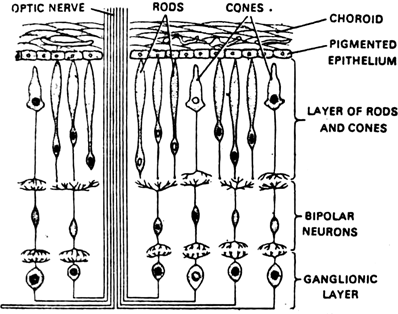 Long Answer Type
Long Answer Type Short Answer Type
Short Answer TypeRetina is the innermost layer. It contains three layers of neural cells – inner ganglion cells, middle bipolar cells, and outermost photoreceptor cells.
The photoreceptor cells present in the retina are of two types – rod cells and cone cells.
(i) Rod cells –The rods contain rhodopsin pigment (visual purple), which is highly sensitive to dim light. It is responsible for twilight vision.
(ii) Cone cells –The cones contain iodopsin pigment (visual violet) and are highly sensitive to high intensity light. They are responsible for daylight and colour visions.
The innermost layer of the ganglionic cells give rise to optic nerve fibre and is connected with the brain.
The point where the optic nerve enters the retina has no photoreceptors and is called the blind spot. At the posterior part, lateral to blind spot, there is a pigmented spot called macula lutea. This spot has a shallow depression at its middle known as fovea. Fovea has only cone cells. They are devoid of rod cells. Hence, it is the place of most distinct vision and has the greatest visual activity or rwesolution.

